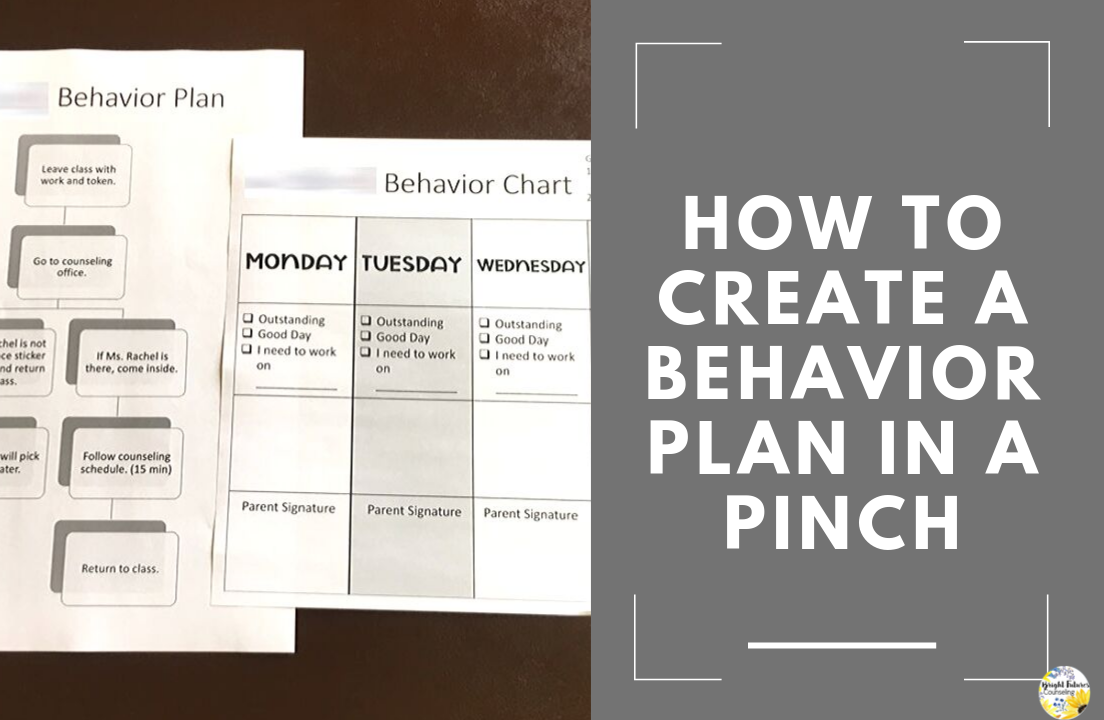Last week I had a student who was having severe behaviors in response to separation anxiety. My principal asked me to quickly come up with a behavior plan and have it ready to present to parents by the afternoon. Basically I had to create a behavior plan in a pinch! Here are the basics in case you have to also.
Create a Plan
My behavior plan consisted of 3 parts:
-
Behavior Plan
-
Behavior Schedule
-
Behavior Chart
Behavior Plan
The actual behavior plan lays out exactly what will happen when the student demonstrates the behavior. For this student, the plan started when he left class to look for his dad.
Identify Replacement Behavior
To stop a particular negative behavior from happening you need to identify a replacement behavior. In my situation, the replacement behavior was for the student to come to my office when he left class instead of running to the parking lot to look for his dad.
Make sure your behavior plan clearly describes each step that will occur. I created this flow chart to demonstrate what will happen when he comes to my office and I even included alternatives for the student to do if I am not in my office. If I am not there he is to place a velcro token on my door to show that he stopped by.
When creating the tokens or any visuals for the student, try to use colors or objects they are interested in to get more student buy-in. I used blue dinosaurs!
Set Clear Expectations
He has 3 tokens to use throughout the day and each one is good for a 15-minute session. I accompany this time limit with a visual timer so he can see exactly how much time he has to complete his behavior schedule.
Behavior Schedule
The behavior schedule clearly states what the student will be doing during each step of the replacement behavior. In this case, it shows what he will do when he comes to my office. I laminated this one and the student uses a dry erase marker to check off each item. He really likes doing this. Find simple ways you can give students ownership of the situation when they likely feel out of control.
Consistency is key! You may be bored of following the same routine up to three times a day but students feel safe and supported when they know what is expected of them. Plus the novelty of going to your office and getting out of class will wear off resulting in your ideal behavior. The behavior schedule is the “boots on the ground” part of the overall plan. Next, you need to track data by creating a behavior chart.
Behavior Chart
Creating a behavior chart allows you to track data, communicate with parents, and motivate the student. Here is an example of the behavior chart I created for this student. It clearly states the goals and has a place for counselor/teacher feedback. It also has a place for the student to receive stickers so he can visually see his success. Finally, at the bottom is a place for parents to sign communicating that they have seen the progress. Download an editable behavior plan and chart in my free resource library here.
Present to Staff and Parents
Present all three parts to parents and remind them that it will be most successful if supported at home. Decide if parents are going to give a reward at home, or if you are at school. You can use a motivation assessment survey to find out what rewards will be most effective. Beware of tangibles. While this can be very motivating for some students, it can be difficult to cap. I try to encourage rewards such as quality time. This could look like them eating lunch with you or coming to your office to play a board game.
Have a Back-Up Plan
You’re not always going to be available so having a team in place is key. Use walkie talkies or figure out an efficient way to communicate with your team so the behavior plan can carry on even if you are away.
Tweak as Needed
Each child responds differently to behavior plans. Present your first draft but be open to change and know that it may vary as the frequency of the behavior decreases. For example, my student was first given three tokens for 15 minutes each but we are gradually taking away a token resulting in him coming on an “as needed” basis only.
Also, be okay with it not working perfectly all of the time. I was seeing so much progress and then we had a major schedule change for a school event and he majorly regressed. This is part of the process.
Don’t Lose Sight of the Goal
I know sometimes it feels like we are rewarding bad behavior when the child leaves class to get quality time with you and a reward, but you have to remember this is better than the original behavior and is only a temporary solution. It also is very time consuming at first, but once the behavior is corrected it will end up saving you time!
Good luck! You’ve got this.









Leave a Reply